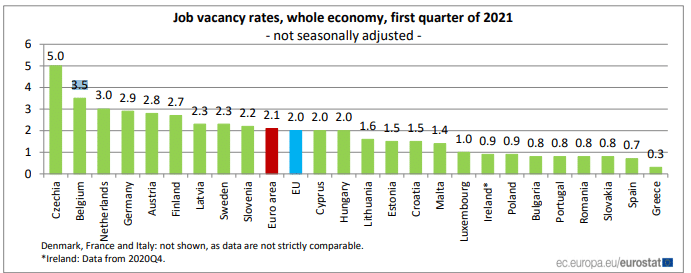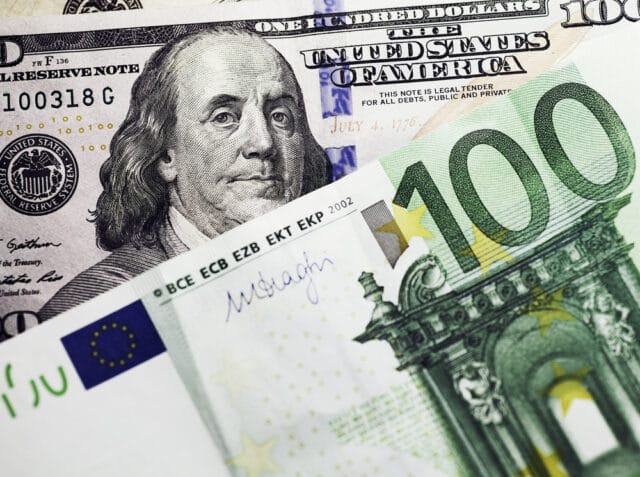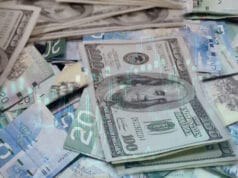- The EU’s rate of job vacancy also rose to 2.0% in Q1 2021 from 1.8% in Q1 2020.
- The index of labor costs dropped 1.50% from a previous reading of 2.80% in the euro area.
- America’s index for export prices jumped 17.4% in May 2021 (YoY) from 14.4%
The EUR/USD traded at -1.02% on June 16, 2021, from the previous day. The pair hit a high of 1.2135 after opening at 1.2124.
The euro lost against the dollar after the rate of job vacancies in the euro area inched up 2.1% in Q1 2021 (year-on-year) from a previous reading of 1.8% in Q1 2020.

Euro area rate of Job vacancies in Q1 2021.
Greece saw the lowest decline in rates of job vacancies at 0.3% as its unemployment rate fell to 16.3% in March 2021 (month-on-month) from 16.6% in the previous month. The EU’s rate of job vacancy also rose to 2.0% in Q1 2021 from 1.8% in Q1 2020.
Labor costs
The euro area’s labor costs (measured per hour) rose 1.5% in Q1 2021. There was a 1.7% rise in the EU’s labor costs in the same period. These statistics factored in wages/salaries and non-wage costs accrued by businesses.
In the eurozone, wages in Q1 2021 (YoY) dropped 2.20% against a previous reading of 3.50% working against the euro. The index of labor costs dropped 1.50% from a previous reading of 2.80%.
Spain, whose rate of job vacancy was 0.7 in the first quarter of 2021, had its economic growth forecast lifted 0.2% from 6.0% to 6.2% in 2021. According to the Bank of Spain, GDP is expected to edge 2.2% higher in Q2 2021 as the country lifts the remaining Covid-19 restrictions.
Further, the government is also pegging GDP growth on increased consumption, with growth set from a range of 4.6% (minimum) to 6.8%. With the public debt deficit running at 4% of the GDP, Spain may see the debt level jump 118% of GDP unless it is contained.
The first batch of the EU’s recovery funds (from the Covid-19 pandemic) was signed off in Brussels in mid-June 2021 at a total of €800 billion. Germany’s 10-year bund auction declined -0.190% from a previous rate of 0.090%.
In the US, the index for export prices in May 2021 (YoY) gained 17.4% from a previous reading of 14.4%. The monthly data beat consensus estimates at 0.8% as it edged up 2.2% from 1.1%.
According to the US Bureau of Labor Statistics (BLS), export prices of consumer goods inched up 0.6% in May 2021 (MoM). The prices of non-Agricultural industrial supplies and materials (NISM) registered the highest monthly/ annual rise among export products at 4.1% and 47.1% (YoY).
Funds rate
The FOMC, on June 16, 2021, kept the federal funds rate at a target of 0-0.25%, pegging its decision on the need to stabilize the labor market. Top of the Fed’s agenda was the need to work to raise inflation towards the 2% zone.
As the regulator seeks to control consumer prices and employment, the Federal Reserve announced a continual increase in Treasury security holdings at $80 billion (per month). Securities backed by mortgages would also be increased by $40 billion (per month) to achieve this stability.
The Federal Reserve also announced an extension of swap lines to maintain the US dollar’s liquidity (temporarily) in 9 central banks to December 31, 2021. Each bank would hold liquidity amounting to $60 billion.
Technical analysis
The EUR/USD chart shows that the pair broke the V-reversal’s trendline (see the blue line) when the downward breakout was confirmed at 1.2180.

EUR/USD Trading Chart
Resistance stood at 1.2265. The pair may find support at 1.1994 or keep trending lower towards 1.1989. Strong selling action has been supported by the 14-day RSI, which is approaching the oversold zone.




